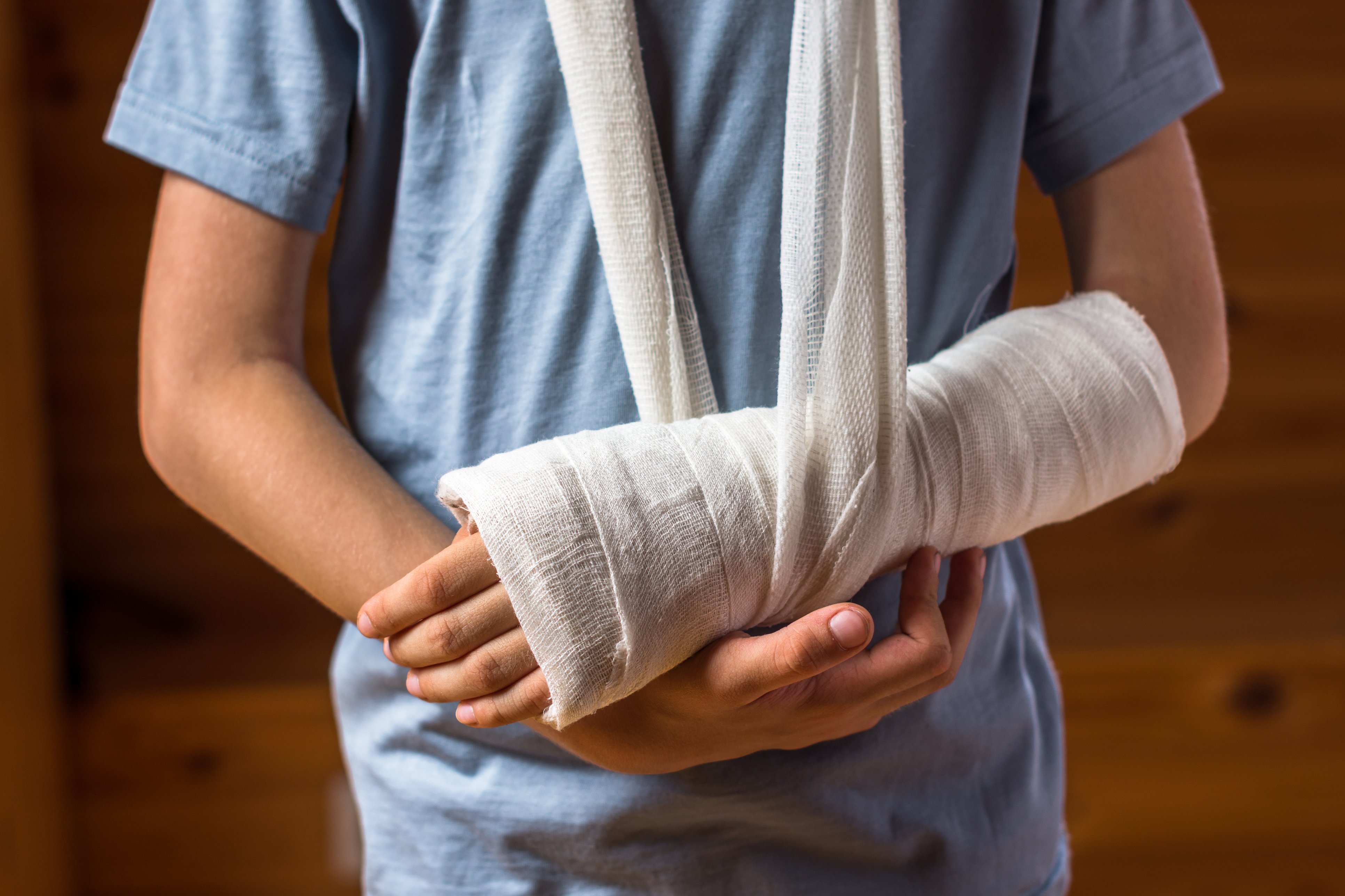The following page will outline things to look for when getting crutches for your child, and instructions for how they should get around using crutches, depending on their level of injury.
Download Crutches: How to use PDF here.
Fitting your child with crutches
For crutches to be safe, they must be measured to fit your child properly. If they do not fit properly, they could make your child more susceptible to falls or other injuries. When fitting your child for crutches, keep the following in mind:
Crutch height
With your child standing up straight with shoulders relaxed, you should be able to fit two to three fingers between the top of the crutch and the underarm (see diagram below).
Handle height
With your child’s arm hanging straight down and shoulders relaxed, their wrist should be at the level of the handgrip; when your child places their hand on the handgrip, the elbow should have a slight bend in it of about 30 degrees (see diagram below).

Walking with crutches
When walking with crutches, it is very important that the body weight be taken through the child’s hands on the handgrips and not through the underarm — your child should not be putting any weight into the top of the crutch. Pressure on the underarms can put pressure on the nerves and blood vessels that supply your child’s arms. This can lead to circulation issues and tingling and numbness in the hand.
To use crutches properly, teach your child the following instructions:
- Your child should keep the crutches in place by squeezing them between the upper arm and the body (see diagram above).
- When placed down, the crutches should hit the ground a few inches wider than shoulder width on either side. This will help to maximize balance and stability, and also allow the body to move between the crutches easily.
Supporting the weight of the body
The amount of weight your child is able to put into their leg will vary depending on the severity of their injury. It is very important that you check with your doctor to find out how much weight your child can put on the affected leg.
Below are the different techniques for supporting body weight with crutches based on how much weight your child’s doctor has ordered:
Non-weight-bearing
Non-weight-bearing is when there is NO weight to be placed on the affected leg as per doctor’s orders. All the child’s weight must be on the crutches and the unaffected leg.
Help your child follow these instructions:
-

Standing on your unaffected leg, lift both crutches at the same time and place the crutches one step’s length in front of you.
-

Push down on the handgrips with your hands while squeezing the top of the crutches between your chest and upper arms.
Putting your weight through the handgrips, hop forward with your unaffected leg to meet the crutches.
Repeat the above 3 instructions.
Feather/touch weight-bearing
Feather/touch weight-bearing is when the child is allowed to put only 10 pounds (4.5 kilograms) of pressure through the affected leg as per doctor’s orders. In this case, your child can rest their toes on the ground without putting any pressure into their foot; all of their body weight should still be in their “good” leg.
Help your child follow these instructions:
-

Standing on your unaffected leg, lift both crutches at the same time and place the crutches one step’s length in front of you.
Bring the affected leg forward so that it is in line with the crutches. Only put your toes down on the ground up to a maximum of 10 pounds of pressure.
-

Push down on the handgrips with your hands while squeezing the top of the crutches between your chest and upper arms.
Putting your weight through the handgrips, hop forward with your unaffected leg to meet the crutches, or slightly ahead of the crutches, making sure that only 10 pounds of pressure is put through the affected leg.
Repeat the above four instructions.
Partial weight-bearing
Partial weight-bearing is when the child is allowed to put only half (50%) of the child’s body weight through the affected leg as per doctor’s orders. This means that they are able to rest some of their weight in the injured leg, but still not enough that they would be able to walk normally.
Help your child follow these instructions:
-

Standing on your unaffected leg, lift both crutches at the same time and place the crutches one step’s length in front of you.
Bring the affected leg forward so that it is in line with the crutches. Only put up to 50% of your body weight on this leg as place it on the ground.
-

Push down on the handgrips with your hands while squeezing the top of the crutches between your chest and upper arms.
Putting your weight through the handgrips, hop forward with your unaffected leg to meet the crutches, or slightly ahead of the crutches, making sure that only 50% of your body weight is put through the affected leg.
Repeat the above instructions.
Full weight-bearing/weight-bearing-as-tolerated
Full weight-bearing/weight-bearing-as-tolerated is when your child is allowed to put the pressure of their full body weight through the affected leg as per doctor’s orders.
Help your child follow these instructions:
-

Standing on both your legs with your crutches at the side of you for support, lift both crutches at the same time and place the crutches one step’s length in front of you.
Bring the affected leg forward so that it is in line with the crutches.
-

Push down on the handgrips with your hands while squeezing the top of the crutches between your chest and upper arms.
Putting some weight through your handgrips and as much weight as you can through your affected leg, step forward with your unaffected leg.
Repeat the above instructions.
Using crutches on stairs
If a stable handrail is available, it is most safe to use one crutch and one handrail for going up and down stairs.

Going up the stairs with one crutch and one handrail
Help your child follow these instructions:
Stand on your affected leg and only put as much weight as allowed as per doctor’s orders on the affected leg. If you are non-weight-bearing you can choose to keep your knee in bent position as shown in the diagram if possible.
Face the stairs holding onto the handrail on one side with a crutch on your other side.
Put pressure through your crutch handgrip and through the handrail as you hop up with your unaffected leg onto the next step.
Then bring your affected leg and crutch up to that step.
Repeat the above steps until you get to the top of the stairs.
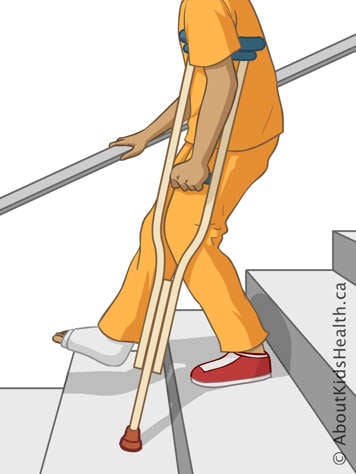
Going down the stairs with one crutch and one handrail
Help your child to follow these instructions:
Stand at the top of the stairs with the toes of your unaffected leg close to the edge of the step.
Hold onto one crutch and the handrail.
Place your one crutch onto the lower step, bringing your affected leg forward at the same time. Only put your affected leg down on the step if allowed as per doctor’s orders.
Putting weight through the handrail and your crutch, slowly lower your unaffected leg onto the lower step, remembering to only put weight through your affected leg only if allowed as per doctor’s orders.
Repeat the above steps until you get to the bottom of the stairs.
For older children with a wider grip, they can choose to use two crutches in one hand and one handrail.
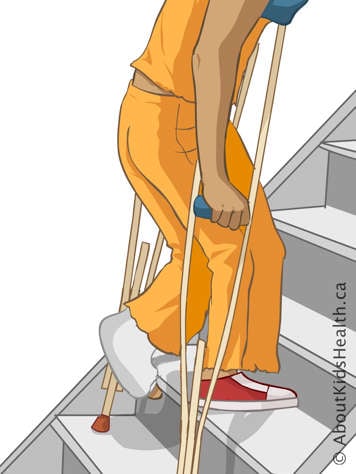
Going up the stairs with two crutches — only when no handrail available
Your child should only go up and down stairs with two crutches if a handrail is not available. For safety reasons, your child should be closely supervised by an adult when using this method.
Help your child follow these instructions:
Face the stairs holding onto your crutches and standing on your affected leg. Only put as much weight as allowed as per doctor’s orders on the affected leg. If you are nonweight-bearing — you can choose to keep your knee in bent position as shown in the diagram if possible.
Put pressure through your crutch handgrips as you hop up with your unaffected leg onto the next step.
Then bring your affected leg and crutch up to that step.
Repeat the above steps until you get to the top of the stairs.

Going down the stairs with two crutches — only when no handrail available
Help your child follow these instructions:
Stand at the top of the stairs with the toes of your unaffected leg close to the edge of the step and holding onto your two crutches, one on either side.
Place your crutches onto the lower step, bringing your affected leg forward at the same time. Only put your affected leg down on the step if allowed as per doctor’s orders.
Putting weight through your crutches, slowly lower your unaffected leg onto the lower step, remembering to only put weight through your affected leg if allowed as per doctor’s orders.
Repeat the above steps until you get to the bottom of the stairs.

Scooting on stairs
If your child is unstable using crutches, your child can also “scoot” up or down the stairs on their bottom.
Help your child to follow these instructions:
To "scoot" upstairs: Turn around and sit on a lower step. Use your arms and unaffected leg to push yourself up the stairs, one step at a time.
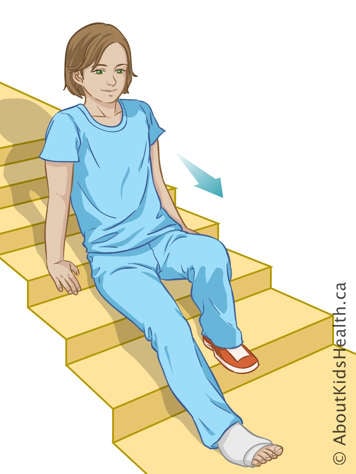
To "scoot" down stairs: Sit down away from the edge of the top step. Scoot forward and use your arms and unaffected leg to lower yourself down the steps, one at a time.
Sitting down and getting up from a chair
Sitting down and getting up from a chair will require more effort while your child has a cast. They will also need to be careful in how they sit down and get up to avoid aggravating their injury. On top of following the instructions below, it will also be easier for your child to get up from a stable chair with solid arms, than from a low, soft couch.
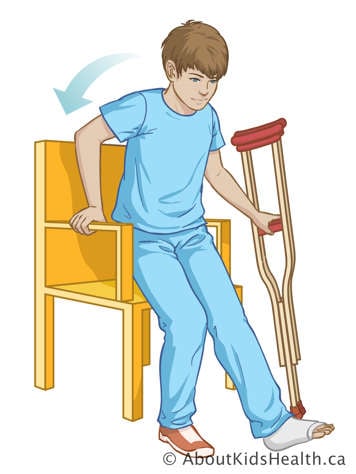
Sitting down
Help your child to follow these instructions:
Standing on your unaffected leg and only putting the allowed weight as per doctor’s orders on your affected leg, make sure the backs of your legs are touching the chair you will be sitting in.
Once you have your balance, remove crutches from your underarms and hold them in one hand by the handgrips.
Hold onto the chair with your other hand and slowly lower yourself into a seated position, only putting as much weight as allowed by doctor’s orders through your affected leg.
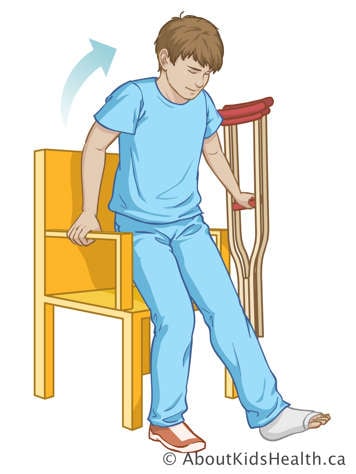
Standing up
Help your child to follow these instructions:
To get up from the chair, hold crutches in one hand by the handrests and push up on the unaffected leg, only putting weight on your affected leg if allowed as per doctor’s orders.
Once you feel balanced, place the crutches under your underarms.
Safety tips
- Have your child look ahead when walking with crutches and be aware of any tripping hazards or any wet spots that can result in slipping. Make sure that there are no loose rugs or cords that your child can trip on. Remove clutter and keep floors clean and dry.
- There is a much higher chance that your child may slip if they are wearing shoes with heels or slippery soles, loose fitting shoes such as flip-flops, or only socks. To avoid slipping, your child should be barefoot or wear well-fitting shoes with rubber or non-skid soles.
- Check the tip or tips of your child’s crutches every few days and replace them if they are worn. You can get replacement tips at your medical supply store or local drugstore.
- Speak to your child’s school about having them leave classes five to 10 minutes early in order to avoid walking in crowds, and to give them more time to get between classes. Have a companion accompany your child to carry their school books or backpack.
- Your child should avoid wearing a backpack or other large bags while using crutches, as they may throw off their balance, or make the crutches more difficult to use.
